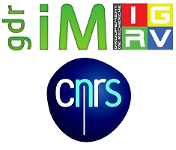Machine/deep-learning recently produced competitive results in medical applications. However, topological aspects are not yet strongly investigated in this context. For example, state of the art statistical intensity model of blood vessels are generated by deep learning with variational auto-encoder in three-dimensional image, whereas topological constraints are not integrated to this model: images reconstructed with such a model may have topological defects such as vessel disconection, loss of bifurcation or creation of undesired holes. In this talk, we propose new methods for computational modeling of anatomical structures with topological consistency, based on deep learning. To tackle this issue, we integrate topological loss functions in the learning process by using the differentiability of persistent homology, with help of digital topology and mathematical morphology. Qualitative and quantitative results on 2567 real CT volume patches and on 10000 artificial ones show the efficiency of the proposed framework.
|
|
|
|
Statistical modeling of pulmonary vasculatures with topological priors in CT volumes
1 : Groupe de Recherche en Informatique, Image et Instrumentation de Caen
Centre National de la Recherche Scientifique : UMR6072, Ecole Nationale Supérieure d'Ingénieurs de Caen, Université de Caen Normandie
2 : Laboratoire d'Informatique Gaspard-Monge
Centre National de la Recherche Scientifique : UMR8049, Université Gustave Eiffel, ESIEE Paris, ENPC
3 : Tokyo University of Agriculture and Technology
|
| Personnes connectées : 1 | Vie privée |

|

 PDF version
PDF version